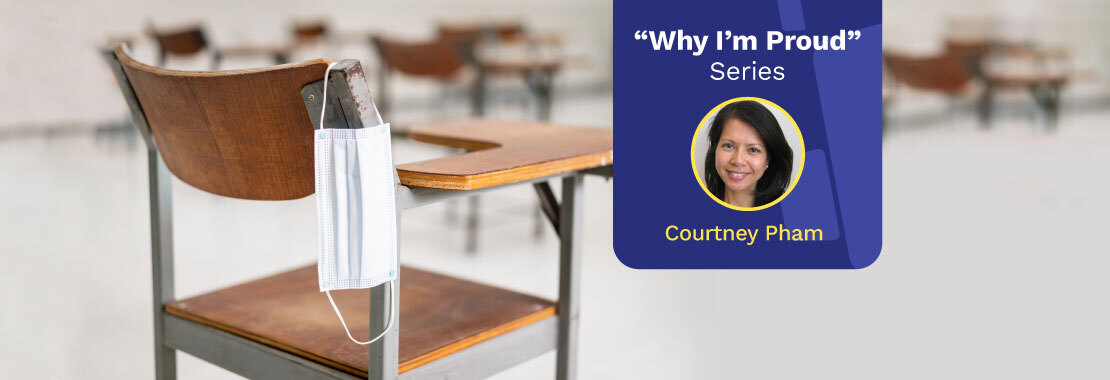Article Summary
- Covid came with complexities, such as pivoting to virtual classes, shifting to new teaching methods, and ensuring students were learning. |New skills have helped improve interactions with students, enhanced resilience, and made work life easier.|Looking back allows us to see the positives amid the challenges.
- field_5cf83622ba22e
Courtney Pham is a Senior Instructor in the College of Business at Missouri State University
There are 385,000 babies born worldwide each day. At one point in time, I was the youngest person on Earth. I proudly held that title for a nanosecond until the next baby was born. It’s true. I am no longer the youngest person on the planet, but I am getting more unique every day, being 1 out of 8 billion people according to the latest count by the United Nations. That acknowledgement along with accomplishments in my personal and professional life make me proud as an individual, especially since 2020.
May I Exhale Yet?
The experience, skills, and education I’ve acquired for the last 50 years have adequately prepared me for the challenges I never saw coming in the academic world. In the shadow of the novel coronavirus, I learned to rely on other instructors, my academic experience, and advanced technologies to deliver consistent quality teaching to my students. Despite the challenges and uncertainties in the past two and a half years, I persevered through this unprecedented upheaval to become a better instructor. I am incredibly grateful to my colleagues, my university’s policies, and to Cengage for helping me with my professional growth. Here are some of the favorite things which I am proud to have achieved after teaching through a pandemic:
Working smarter, not harder
This has become my favorite mantra since May 2020. Through the Cengage Faculty Partnership Program, I received requests from Las Vegas to Texas to Massachusetts to collaborate with other instructors on how to restructure and build their courses from an in-person to an online modality. The concern most of us had was how to keep the quality content without overwhelming our students. Most of us reassured ourselves that others had the same approach while making everything more manageable with quick turnarounds. The perfect approach was to use existing resources already available.
If your publisher is like mine and offers a smorgasbord of digital solutions, from eTextbooks to online learning platforms to digital tools—take advantage! Having the mix of options helped alleviate a lot of stress for me. During Covid, many of us concluded that pre-built modules were the way to go. Many of the eTextbooks I use offer case studies, videos, and mini-applications that are relevant to the topics I cover in my course. For me, solutions with gradebook features provide tremendous help as backend support. These features allow me to do a quick analysis. I see which students are engaging, and whether they are struggling, so I can reach out with help. It saves me so much time and frustration so I can redirect my energy to something more pressing.
Adapting to changes
Covid came with complexities that altered my plans and forced me to adapt. Pivoting my seated classes to virtual classes within one week, and then back to seated classes was a challenge. The ability to shift teaching modality to new formats helped me develop my capability to provide flexibility in teaching methods. It required getting comfortable with using different technology that works for various modalities and ensuring students are on the same page and learning as effectively as they could under the circumstances. I organized my online class meetings for the students to get a chance to meet me and interact in a way that fits their schedules. I found that through this method, students from my online classes were more engaged than they were in a fully asynchronous class. This is also a testament to how cooperative the students were. They understood that by providing live and on-demand meetings and lectures, I was doing my best to provide an effective learning environment during these trying times.
Building Power Skills
According to Josh Bersin, an HR educator, future skills are not technical, but more behavioral, which he called “power skills.” It takes effort to acquire these power skills—or soft skills—such as good time management, accountability, empathy, resilience, and collaboration. In the last couple of years, I have been refining my power skills to make me more resilient. I rely on these soft skills during difficult times. I turned them into survival skills to enable me to be patient and stay positive. Through these skills, I became a better communicator and an empathetic instructor. I learned to conduct more engaging Zoom sessions and work remotely with my online students. These skills facilitate my interaction with my students in a harmonious way and make my professional life a lot easier.
It’s always helpful and nostalgic to look back. At the same time, I want to think of it as a mini celebration—to reorient myself and focus on the positives amid the challenges of teaching through a pandemic. I believe that making it through hard times is an accomplishment. These reflections help me narrow down the answers to the question I often ask myself, “How am I different after these challenging years?”
With this zenergy (zen + energy), I have been leveraging my newfound knowledge and newly acquired skills. I know I am making a difference based on end-of-semester evaluations from my students. It’s an impetus to me to always be curious, look forward to learning new skills, and incorporate innovative ideas. This helps me carve out a niche as an instructor at Missouri State, so I may become unique among the sea of 8 billion people.
Read the rest of the posts in our series to see what other faculty members are most proud of after teaching through a pandemic.

